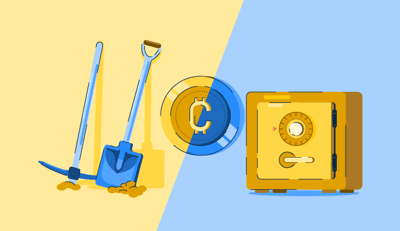July 3, 2024
 by Washija Kazim / July 3, 2024
by Washija Kazim / July 3, 2024

In the world of crypto, coins speak louder than words.
Since blockchains aren’t governed by any financial institution, a centralized authority that validates all transactions is necessary. Or better yet, an entire troop of gatekeepers.
A method called proof of stake (PoS) chooses these gatekeepers to make a blockchain impenetrable and maintain the integrity of cryptocurrencies.
Proof of stake (PoS) is a method for securing blockchains in which users validate transactions based on the amount of cryptocurrency they "stake." The more crypto someone stakes, the higher their chance of being chosen as a validator. Validators add new blocks to the blockchain and earn rewards.
A consensus mechanism, like PoS or proof of work (PoW), is a vital component of distributed systems like blockchain networks and cryptocurrencies. It’s a set of rules or algorithms that participants in a blockchain network use to register their agreement on the validity of crypto transactions.
Many cryptocurrency wallets support staking functionality, which permits users to participate in the block validation process without depending on external services. Validators can stake their coins directly from their wallets and earn rewards for securing the network.
Proof of stake and proof of work, designed to validate and secure blockchain networks, are the two main consensus mechanisms used to process cryptocurrency transactions, but they still have their differences.
.png?width=600&height=375&name=Proof%20of%20stake%20vs%20Proof%20of%20work%20(1).png)
Proof of work is the first blockchain consensus that was pioneered by Bitcoin (BTC). The term “proof of work” comes from all of the mathematical and computational work participants have to do to process crypto transactions. The validators compete with each other when they’re cryptocurrency mining – the first one to solve the puzzle gets to update the blockchain and earn a reward in crypto.
However, due to its energy-intensive nature, proof of work has faced trouble scaling up to accommodate the massive volume of crypto transactions. The computational work makes it costly and time-consuming to produce new blocks. As a result, proof of stake has emerged as an alternative.
In a proof of stake system, a network participant is selected as a validator based on who is willing to stake their crypto to perform transaction validation. The one who has the biggest amount of crypto in the pool for the longest time is the winner.
Since PoS relies on the economic incentives of stakeholders instead of massive computational power, it’s considered more energy-efficient than PoW. While Bitcoin is still associated with PoW and relies on Bitcoin mining, Ethereum switched to a PoS in 2022.
Did you know? A mining pool combines the computational powers of individual miners to increase their chances of winning. For cryptocurrencies under PoS, there’s a similar concept called staking pool, wherein a group of people pools their coins together for a better outcome.
In a centralized system, when one entity manages all transactions, the fear of double spending doesn’t exist. But cryptocurrencies don’t work like that. No leader is in control of the system, keeping records. Instead, thousands of users are spread over the globe, resulting in a sprawling infrastructure.
To tie this system together, you need a consensus mechanism that can align all users to agree on the state of the system and reach a common decision regarding the validity and the order of the next block. Proof of work was the first consensus mechanism that established a decentralized system.
However, the heavy computational effort needed in a PoW system was unsustainable. PoS uses staking, which relies on ownership of coins. It randomizes the process instead of making people compete to solve mathematical puzzles. This results in a drastic reduction in energy consumption, which then minimizes network congestion and transaction fees.
Some of the major proof of stake cryptocurrencies include Solana, Tezos, and the following:
Under the PoS system, cryptocurrency owners stake their coins in exchange for a chance to validate new blocks of transactions on the blockchain. When staking, coin holders transfer some of their holdings to a staking address or smart contract within their crypto wallet. The owners stake their coins and create validator nodes representing their active participation in the consensus process.
Then, the selection takes place according to the amount of cryptocurrency staked. The owner's chances of being chosen increase in proportion to their stake, so the more cryptocurrency an owner stakes, the higher their chance of being chosen.
To maintain integrity, if a validator adds fraud transactions, their stake is deemed useless or “burned” by sending it to an unusable wallet address that no one can access.
*These are the five leading cryptocurrency wallets as per G2’s Spring 2024 Grid® Report.

Proof of stake offers a unique security model compared to proof of work, which relies on miners' computational power. PoS incentivizes honest behavior and discourages malicious activities by aligning validator interests with network security and creating a strong economic incentive for honest participation.
The main thing to look out for with PoS is the distribution of stakes. If a small group of users holds a majority of the staked coins, they could potentially gain unfair control over the network. This is why a well-distributed stake pool is crucial for robust PoS security.
PoS is a developing technology compared to PoW's established track record and needs more time to prove its long-term resilience against sophisticated attacks.
Different blockchain projects choose different consensus algorithms depending on their goals, but proof of stake has emerged as the better alternative to the original consensus mechanism, proof of work.
Some of the benefits that pushed PoS beyond PoW are discussed here:
Proof of stake solved many problems raised by proof of work, but it’s not perfect.
A. Proof of stake comes with risks like losses related to mistakes or fraud. It also faces the challenges of centralization and the “nothing at stake” phenomenon.
A. Both consensus mechanisms have their own set of strengths and weaknesses. PoS is suitable if you’re looking for energy-efficient, scalable, and higher decentralized solutions, whereas PoW is a better fit if you want proven reliability and a fair distribution of rewards.
A. Proof of stake (PoS) is seen as an upgrade to proof of work (PoW) for its efficiency. PoS uses far less energy and scales better than PoW's compute-intensive mining. While PoW offers established security, PoS incentivizes honest behavior through staked crypto, potentially leading to a more decentralized network. Both have trade-offs, but PoS is emerging as a sustainable alternative.
A. Bitcoins operate on proof of work. Converting to proof of stake requires significant changes to the existing protocols. Also, 51% of the community must favor proof of stake for Bitcoin to convert. Since this community is full of miners who profit from proof of work, it’s highly unlikely that Bitcoin will ever switch to proof of stake.
A. No, Bitcoin is not a PoS blockchain. It uses PoW for transaction validation, which is why Bitcoin mining consumes a significant amount of energy.
A. The Ethereum blockchain operated on PoW until 2022 when it successfully transitioned to PoS as part of its Ethereum 2.0 upgrade.
Your quest for a sustainable consensus mechanism is over. Proof of stake has all but eliminated the need for energy-intensive crypto mining and established ownership as the new regime for validating crypto. It fosters a secure and decentralized network, encouraging higher participation and paving the way for a scalable blockchain ecosystem.
As blockchain technology evolves, proof of stake is bound to play a pivotal role in the future of decentralized technologies, unlocking a realm of unprecedented possibilities for digital assets.
Not ready to let go of the traditional ways yet? Check out the best cryptocurrency mining software.
This article was originally published in 2023. It has been updated with new information.
Washija Kazim is a Sr. Content Marketing Specialist at G2 focused on creating actionable SaaS content for IT management and infrastructure needs. With a professional degree in business administration, she specializes in subjects like business logic, impact analysis, data lifecycle management, and cryptocurrency. In her spare time, she can be found buried nose-deep in a book, lost in her favorite cinematic world, or planning her next trip to the mountains.
Mine or stake? It’s time to make a choice.
 by Washija Kazim
by Washija Kazim
In a world of digital asset supremacy, robust security is the need of the hour.
 by Washija Kazim
by Washija Kazim
Like any other industry, the tech sector isn’t immune to falling victim to hype from...
 by Tim Keary
by Tim Keary
Mine or stake? It’s time to make a choice.
 by Washija Kazim
by Washija Kazim
In a world of digital asset supremacy, robust security is the need of the hour.
 by Washija Kazim
by Washija Kazim


